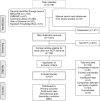No evidence on the effectiveness of oral splints for the management of temporomandibular joint dysfunction pain in both short and long-term follow-up systematic reviews and meta-analysis studies
- PMID: 32364348
- PMCID: PMC7222619
- DOI: 10.5125/jkaoms.2020.46.2.87
No evidence on the effectiveness of oral splints for the management of temporomandibular joint dysfunction pain in both short and long-term follow-up systematic reviews and meta-analysis studies
Abstract
The aim of this study was to determine the efficacy of oral splints in reducing the intensity of pain in patients with temporomandibular joint dysfunction in both short and long-term treatment durations. Electronic databases, Cochrane Library, MEDLINE via PubMed, Web of Science, Egyptian Knowledge Bank, and EMBASE were searched for randomized controlled trials comparing different types of splints to non-occluding splints, behavioral therapy, pharmacotherapy, counseling, and no treatment. The risk of bias was assessed by using Cochrane risk of bias recommendations. Fixed and random effects were used to summarize the outcomes. The effect estimates were expressed as standardized mean differences (SMD) or risk ratios with a 95% confidence interval (CI). Subgroup analyses were carried out according to the treatment duration. Twenty-two studies met the inclusion criteria. A meta-analysis of short-term studies up to three months revealed no significant difference between the study groups. However, long-term studies exhibited a significant difference in pain reduction in favor of the control group. Total analysis revealed that the control group resulted in significant pain reduction (SMD 0.14, 95% CI 0.05-0.23, P=0.002, I2=0%). Oral splints are not effective in reducing pain intensity or improving function in patients with temporomandibular joint dysfunction.
Keywords: Meta-analysis; Occlusal splints; Pain; Review.
Conflict of interest statement
No potential conflict of interest relevant to this article was reported.
Figures





References
-
- Garrigós-Pedrón M, La Touche R, Navarro-Desentre P, Gracia-Naya M, Segura-Ortí E. Effects of a physical therapy protocol in patients with chronic migraine and temporomandibular disorders: a randomized, single-blinded, clinical trial. J Oral Facial Pain Headache. 2018;32:137–50. doi: 10.11607/ofph.1912. - DOI - PubMed
-
- Ouanounou A, Goldberg M, Haas DA. Pharmacotherapy in temporomandibular disorders: a review. J Can Dent Assoc. 2017;83:h7. - PubMed
-
- De la Torre Canales G, Manfredini D, Grillo CM, Guarda-Nardini L, Machado Gonçalves L, Rizzatti Barbosa CM. Therapeutic effectiveness of a combined counseling plus stabilization appliance treatment for myofascial pain of the jaw muscles: a pilot study. Cranio. 2017;35:180–6. doi: 10.1080/08869634.2016.1168071. - DOI - PubMed
LinkOut - more resources
Full Text Sources
Miscellaneous

